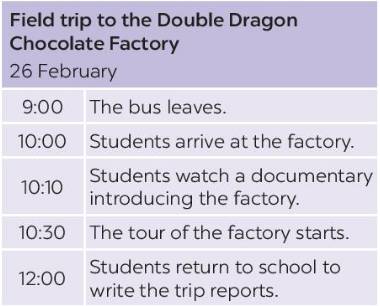Insert it is/there is in the spaces. In some sentences, contracted plural, negative and interrogative forms, or the past or future tense are required.
16 . .. . .. ... lunch time when we get to York, so let's have lunch there.~No, ... ... not be time for lunch because our train to Edinburgh leaves York at 13.15.
17 ... ...a funny smell here. ... ... turpentine?
18 ... ...all sorts of stories about Robin Hood, but ... ... not known exactly who he was or what he did.
19 ... ... said that if you break a mirror you'll be unlucky for seven years.
20 As he had very bad sight ... ... difficult for him to recognize people.
21 Can I have a Telegraph, please? said the customer. Im afraid ... ... not any left said the newsagent. But . . . . . . a Guardian on the rack beside you. Why not take that? ... ... just as good.;
22 ... ... not necessary to carry your passport everywhere with you but ... ... advisable to carry some document of identity.
23 ... ...a guard outside the door and ... ... bars on the windows. ... ... impossible to escape.
24 ... ...a garage behind the hotel? ~ Yes, but ... ... rather full. I don't think ... ... room for your car.
25 One night . . . . . . a heavy fall of snow which blocked all the roads. Luckily ... ... plenty of food in the house.
26 ... ...a hotel in the village, so we decided to stay there. . . . . . . a charming village and I was very happy there, but my children were bored because ... ... nothing to do in the evenings.
27 ... ... five flats in the building—one on each floor. Mine's on the top floor. . . . . . . no lift but ... ...supposed to be good for the figure to run up and down stairs, . . . . . .?
28 ... ...a pity you haven't another bedroom. ~ Yes, but ... ... quite a big loft, which I am thinking of turning into a bedroom. . . . . . . a skylight so ... ... not . . . a ventilation problem.
29 ... ...all sorts of legends about these caves. ... ... said that smugglers hid their goods here and that . . .. . . an underground passage leading to the village inn.
30 Tell me something about King Lear. ~ ………... the story of a king who divided his kingdom between his daughters. ... ... foolish to give away your property like that. . . . . . . never certain that your family will behave generously to you in return.
31 Has Tom any more children?~ Yes. . . . . , . a daughter, Ann.~ Oh yes, ... ... Ann who opened the door to us yesterday, . . . . . .?
32 He thought that ... ... better to say nothing about his change of plan.
33 . .. ...a long time before I got an answer. Then one day a letter arrived—well, ... ... not really a letter,... ... only one sentence on the paper.
34 ... ...a pond beside your house? - Yes, . . . . . . ~ How deep . . . . . .?
35 We'e done all we can. ... ... nothing to do now but wait.
36 Just cross out that word and go on.... ... not necessary to begin again. (or... ...no need to begin again.)



1 What's the time? - ...It is ... 3.30. ~ And what's the date? ~ . . . it is. . . the 24th.
2 How far... is it...to York? ~ . . . it is. . . 50 miles.
3 ... ..It was. very stormy last night. ~ Yes, ..there were. ... storms all over the country.
4 ...It is ... freezing very hard. ...There will be ...ice on the lake tomorrow.
5 As... .it was.. sunny she decided to take the children to the sea.
6 Why don't you go for a walk? . . . . It is. . a pity to stay in when . .it is . . . . so nice outside.
7 ... There are... not any shadows because ...there is ... not any sun.
8 ...There is ... going to be a bus strike tomorrow. ~ ... ... It will be..all right if ... .it is.. a fine day; but if ... it is... wet ... .There will be.. ...long queues on the Underground.
9 ... There is... not any glass in the windows; that is why . . . .it is . . so cold in the room.
10 ...It was ... very wet yesterday; ... It was... impossible to go out.
11 ...There was ...a lot of rain last week. ...There were ... floods everywhere.
12 ... ..There was .a thick fog last night. ... ..There were. several accidents on the motorway.
13 ... ..It is. foolish to drive fast when ... ..it is. foggy.
14 ... .It is.. difficult to find your way round this town. . . .There are . . . so many streets all looking exactly alike.
15 Come on, children! ...It is ... time to get up! ..It is. ... nearly breakfast time.